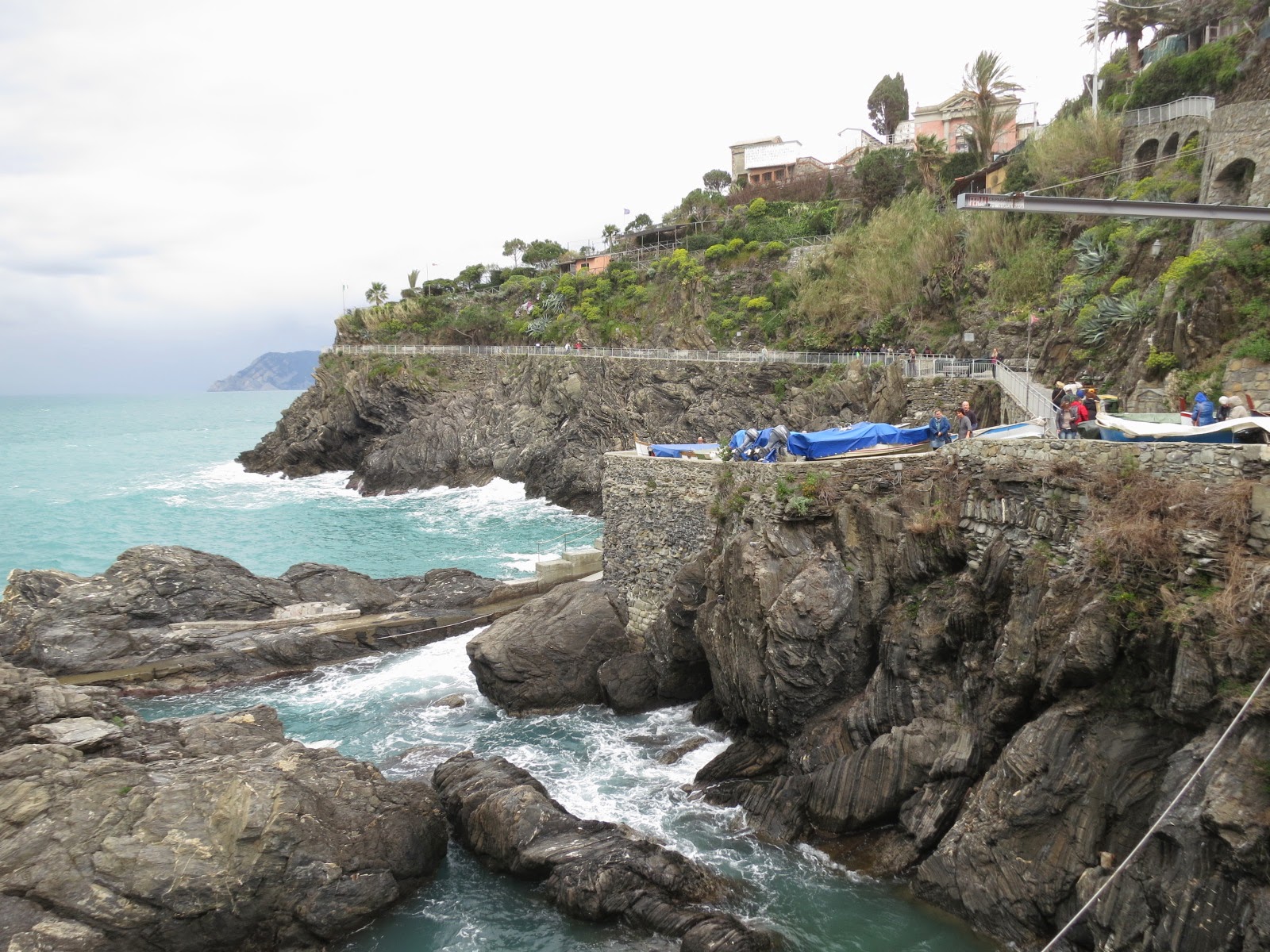We also passed several "bread factories." We ate lots of Italian breads including ciabatta and foccacia. Waiters served bread with every meal, along with olive oil and balsamic vinegar. Pizza, also considered a bread, got it's humble beginnings as street food in Napoli and Queen Margherita is partly responsible for spreading the pizza craze to all corners of the globe. We learned from Claudia that Italian bread has no salt because years ago there was a tax on salt and the bakers were stubborn and refused to pay the tax so they left salt out of the bread. They reasoned that salami and pesto has enough salt to flavor even the bread, when eaten together.
Pictures of the Apuan Alps taken while parked at a rest stop. These Alps are famous for white marble.
The bus driver dropped us off at La Spezia and we rode the train to three of the five villages in Cinque Terre.
Photo shoot in Manarola
Fishermen painted their houses in bright colors so they were easily visible from the sea.
It's typical to see laundry drying outside all over Tuscany.
From Wikipedia: The first historical documents on the Cinque Terre date back to the 11th century. Monterosso and Vernazza sprang up first, whilst the other villages grew later, under military and political supremacy of Genoa. In the 16th century to oppose the attacks by the Turks, the inhabitants reinforced the old forts and built new defence towers. From the year 600, the Cinque Terre experienced a decline which reversed only in the 14th century, thanks to the construction of the Military Arsenal of La Spezia and to the building of the railway line between Genoa and La Spezia. The railway allowed the inhabitants to escape their isolation, but also brought about abandonment of traditional activities. The consequence was an increase in poverty which pushed many to emigrate abroad, at least up to the 1970s, when the development of tourism brought back wealth.
The variation of house colors is due to the fact that while fishermen were doing their jobs just offshore, they wanted to be able to see their house easily. This way, they could make sure their wives were still home doing the house work. Most of the families in the five villages made money by catching the fish and selling them in the small port villages. Fish was also their main source of food.
The Cinque Terre is a rugged portion of coast on theItalian Riviera. It is in the Liguria region of Italy, to the west of the city of La Spezia. "The Five Lands" comprises five villages: Monterosso al Mare, Vernazza, Corniglia, Manarola, and Riomaggio.
Over the centuries, people have carefully built terraces on the rugged, steep landscape right up to the cliffs that overlook the sea. Part of its charm is the lack of visible corporate development. Paths, trains and boats connect the villages, and cars cannot reach them from the outside. The Cinque Terre area is a very popular tourist destination.
We walked through a tunnel, to the old section of Monterosso for lunch.
The waiter charmed us with his wit and patience when we asked a lot of questions.
Toni watched, with anticipation, as he deboned the whole fish she'd ordered

 Paula and I shared an order of grilled Scampi and Trofie Pasta with Pesto Sauce.
Paula and I shared an order of grilled Scampi and Trofie Pasta with Pesto Sauce. The lighting and table settings impressed us as well as the scrumptious food and wine.

We had a little time before our train left so we walked up the street and Paula befriended this sweet boy who painted rocks. She paid him for a shark-shaped rock. We stopped long enough for a pictures among the marguerite daises.

Our next stop, Vernazza
Paula and I walked to the Church. It was raining so spending quiet time was a nice respite for us. I don't know the name of the church, but it was decorated by and for fishermen.

View of Vernazza from the Church
Claudia pointed out the Carrara Marble quarries on the trip back to Montecatini. There are 770 quarries in the city. Sculptors use this marble mostly for statutes. We noticed lots of cranes and huge pieces of marble ready for shipment.
Claudia also gave us a little geography lesson about the Liguria area, where Cinque Terre is located. Parts of this area are also called the Italian Riviera, along the Mediterranean Sea. She said many Italian families have summer homes in this area. When she mentioned the province bordered France I thought about Bradleigh, my granddaughter, who will be flying to Paris on Friday. I think Nice is just across the sea from Cinque Terre.
A=Nice in France; B=La Spezia




















No comments:
Post a Comment